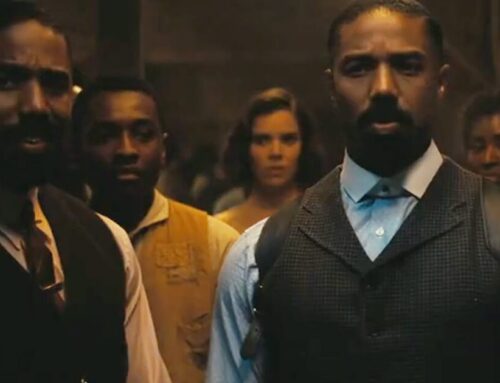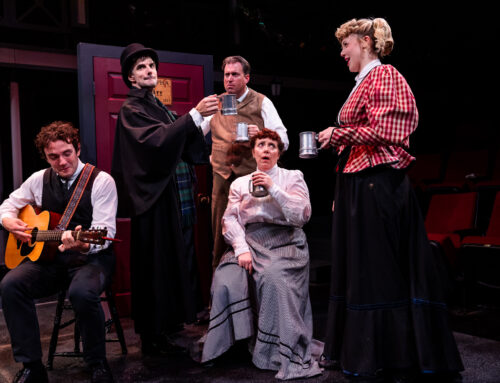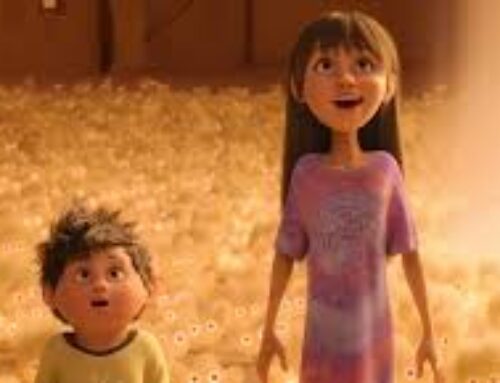ONCE UPON A TIME… IN HOLLYWOOD is easily THE film of the summer, the year thus far, and maybe the decade. It’s a climactic showstopper of an achievement, Quentin Tarantino’s avowed penultimate 9th movie, a full-to-bursting valentine to movie-making and movie stars, his native Los Angeles, and an industry mirroring the turbulence of a culture on the cusp. It’s a rare hybrid of fact & fairy tale, history, memory, and fantasy, wrapped in nostalgia, grounded in meticulous detail and propelled by the artistry, obsession, and love of a filmmaker with silver nitrate running through his veins.
The story begins once upon a time in Hollywood 1969 where two men, an actor and his stunt double, struggle to keep working and relevant as they close in on their career expiration dates. Leonardo DiCaprio plays Rick Dalton macho star of a late 50’s early 60’s western TV series called “Bounty Law” who is trying to make his way into movies by taking roles as heavies; both he and his career are taking a beating.
Brad Pitt who plays his longtime stunt double and pal, Cliff Booth, is capable of the real things that his star alter ego is not: he’s indestructible. He may have also killed his ex-wife. In a series of long takes, Tarantino orchestrates a wildly funny and punishing contretemps between Cliff and a pompous Bruce Lee (Mike Moh) who gets as good a pummeling as he gives. In another long sequence Cliff demonstrates supreme control over his fierce pit bull Brandy, taking his time emptying two cans of dog food into her bowl, while the carnivorous canine never flinches until the top dog gives the OK. These sequences are not only dramatically absorbing in the moment, but also pay off down the road as Tarantino carefully lays the groundwork for an explosive climax.
The inspired first-time onscreen pairing of seasoned real-life mega-stars DiCaprio and Pitt make the fictitious Rick and Cliff struggling to hang on as an era passes them by, all the more poignant. These square-jawed, pompadoured leading men find themselves falling to the introspective anti-heroics of longhaired hippies, and know the counter culture is closing in. In fact, rising stars Sharon Tate and her hot new Polish filmmaker husband Roman Polanski have just moved in right next door to Rick on Cielo Drive. And there we have the arc of the film, its two-and-a-half day timeframe bending toward that gruesome night when Charles Manson and his gang hacked a hole in Hollywood’s heart.
Our foreknowledge of this history tweaks the tension of the tale Tarantino is spinning but we willingly follow these characters into the woods and through a series of shootouts and showdowns. Along the way Tarantino serves up a feast of Hollywood stars and landmarks to flesh out the fable. We’re at the bar of classic Hollywood hangout “Musso & Frank’s” where the drinks have giant garnishes, and in strolls Al Pacino as a slick and savvy talent agent. Later, it’s Kurt Russell who walks through the door as a budget-conscious producer trying to get Rick to ditch Cliff because he can’t afford him. Check out Damian Lewis looking uncannily like a cool-eyed Steve McQueen. Watch for an elegant, graying Luke Perry in what no one could have known would be his last onscreen role.
When Cliff shows up at the now dilapidated Spahn Ranch once used as a movie set for westerns he uncovers a clot of drugged out hippies curdling into the Manson gang. Look for Lena Dunham as “Gypsy” and a truly scary Dakota Fanning as “Squeaky” Fromme. And then there’s the way Tarantino makes us wait as Cliff cautiously approaches the back bedroom of a rat-infested house where a wild-eyed white-haired Bruce Dern (the late Burt Reynolds was to have played the part) rolls over to reveal himself as flea-bitten ranch owner George Spahn. He may or may not be a hostage to the varmints who’ve overrun the place, but Tarantino clearly owns us. He masterfully calibrates scene after scene, taking his time, laying in the details we feel even if we don’t see them, building suspense and pulling the trigger on these magnificent set pieces.
Shot in 35mm by Tarantino’s trusty DP Robert Richardson, the movie looks the way I remember movies looked, in the theater and on TV as I sat on the living room rug watching “Bonanza,” “The Rifleman,” “Mannix.” The way the actors self-consciously wore their characters, the unmistakeable light and texture of these images that take us right back to a very specific place and time, its sounds and sights, cars, commercials, clothes, music on the radio; and it’s analogue all the way. The Van Nuys Drive-In has been recreated in miniature with real cars not digital facsimiles. The freeway was shut down for miles and a pageant of wide-bodied, big finned candy-colored convertibles were sent sailing down Hollywood Blvd in the LA sunshine.
There’s something visceral and exhilarating about Tarantino’s films. I think they get under our skin, because the filmmaker has so much skin in the game. His enthusiasm for the process and the product as well as his compassion for the actors beneath their star facades is palpable. There’s a scene where Margot Robbie as Sharon Tate in white go-go boots pops into a movie theater in the middle of a sunny afternoon to watch one of her own movies. Anonymous in the dark, she puts her bare feet up on the seat in front of her, plops on a pair of giant glasses, and surrenders to her own and the audience’s delight in seeing her image up on the big screen. And who’s on that screen? The real Sharon Tate in fight scenes from her movie “The Wrecking Crew,” intercut with scenes of Robbie as Tate being trained by Bruce Lee! We watch Robbie in closeup; her blonde beauty is more of our time, more sensual and less ethereal than Sharon Tate’s pristine visage, but she captures Tate’s innocence, joy, and vulnerability on the precipice of fame.
Later in another scene, this one apparently improvised, we watch Rick unmasked and it may win Leo another Oscar. After blowing his lines in a key moment on set, Rick slinks back to his trailer alone, where we witness his escalating anguish through a series of quick jump cuts, his self-flagellation an opera of agonizing self-doubt and recrimination. It’s an emotionally raw scene and we want to die for him.
Which brings us to that fateful night. Without giving anything away, I will tell you that Tarantino has enacted a graphic, glorious, sizzling climax to challenge the one we associate with the events of August 8, 1969. He has us screaming and laughing and on the edge of our seats, through horror and disbelief, creeping down Cielo Drive as the camera lifts up and away. In the universe of this rambunctious storyteller’s imagination, history is a mere plaything and re-collection is all. Building on the themes, motifs, and sequences from his previous 8 films, Tarantino has generated images so layered and felt, we know we’re passing through the landscape of deeply cherished memory, breathing that air, utterly there, and on our way to somewhere new.
The deepest wish of this movie is to hold onto the past– while not giving up the future either. It’s a future that would welcome renegade filmmakers like Quentin Tarantino whose indie spirit gave free rein to their idiosyncratic fantasies. ONCE UPON A TIME … IN HOLLYWOOD is an unsettling fairy tale, invoking the fizzy promise and shifting undercurrent of a tumultuous time, then and now, pulling us forward into the past.






Leave A Comment
You must be logged in to post a comment.